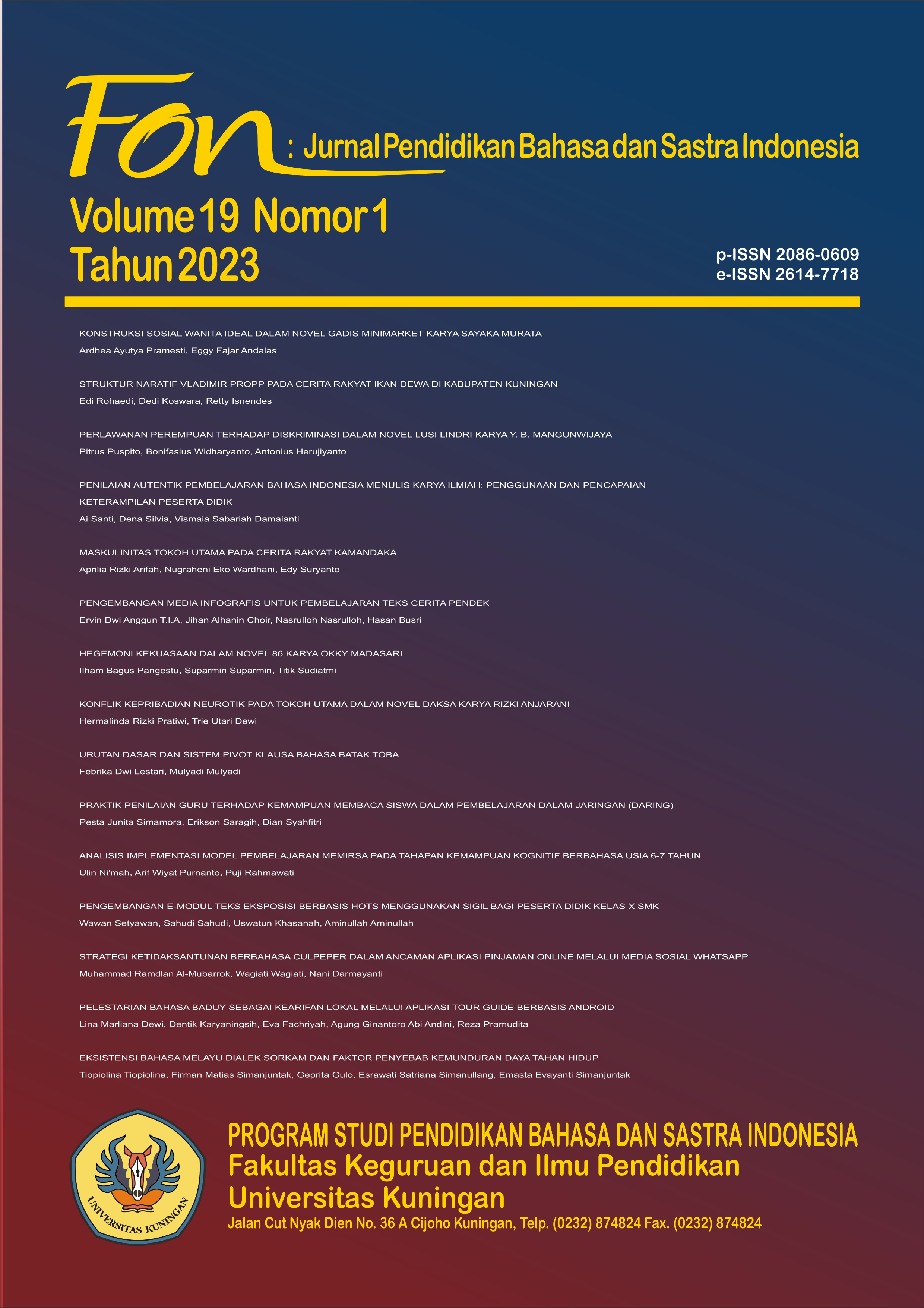URUTAN DASAR DAN SISTEM PIVOT KLAUSA BAHASA BATAK TOBA
Abstrak
ABSTRAK: Penelitian prototipe word order Bahasa Batak Toba (BBT) ini memiliki tujuan untuk menggambarkan karakteristik tata urut kata dan sistem pivot BBT dan menginterpretasikan tipologi BBT berdasarkan karakteristik sintaksis klausanya. Dalam pelaksanaannya data dianalisis dengan menggunakan metode agih dengan teknik ganti dan ubah-ujud. Pengujian pivot dilakukan terhadap konstruksi klausa koordinatif dan subordinative. Hasil uji pivot menunjukkan bahawa pola urutan kata VOS merupakan prototipe yang lazim dalam BBT. Penganalisisan data secara tipologis menunjukkan simpulan dari penelitian ini adalah bahwa BBT digolongkan kepada kelompok bahasa akusatif secara sintaksis. Hal tersebut tercermin lewat S yang diperlakukan sama dengan A, dan ada perlakuan berbeda untuk P. selanjutnya pengujian pivot memperlihatkan bahwa FN pada BBT dapat dilesapkan secara langsung apabila FN tersebut berada dalam fungsi S atau A. sebaliknya jika FN ada pada fungsi P maka hal pelesapan tidak bisa dilakukan secara langsung. Pelesapan dapat dilakukan dengan cara pemasifan atau pentopikalisasian salah satu klausa terlebih dahulu. Dari hasil pola yang dihasilkan diatas maka dapat dismpulkan bahwa BBT adalah bahasa dengan tipologi akusatif dengan merujuk pada sistem pivot S/A.
KATA KUNCI: Word OrderKlausa; Sistem Pivot; Bahasa Batak toba.
TOBA BATAK LANGUAGE WORD ORDER PROTOTYPE (PIVOT SYSTEM OF CLAUSE BASIC ORDER).
ABSTRACT: This prototype research on the word order of the Toba Batak Language (BBT) aims to describe the characteristics of the word order and pivot system of BBT and interpret BBT typology based on the characteristics of the clause syntax. The data were analyzed using the distribution method with substitution and transformation techniques. Pivot testing is carried out on the construction of coordinative and subordinate clauses. The pivot test results show that the VOS word order pattern is a common prototype in BBT. Typological analysis of the data shows the conclusion of this study is that BBT is classified into the accusative language group syntactically. This is reflected through S which is treated the same as A, and there is a different treatment for P. Furthermore, the pivot test shows that FN in BBT can be eliminated directly if the FN is in the S or A function. Conversely, if FN is in the P function, the dissolution can't be done directly. Omitting can be done passively or by topicalizing one of the clauses first. From the results of the pattern produced above, it can be concluded that BBT is a language with an accusative typology with reference to the S/A pivot system.
KEYWORDS: Word Order; Clause; Pivot System; Toba Batal Language.
Referensi
Alimin, F. G. (2022). 2022-Buku Tipologi Bahasa (Issue March).
Artawa, I. K. (1994). Bahasa Bali-Sebuah KajianTipologi Sintaksis (p. 15).
Basaria, I. (2016). Tipologi Gramatikal dan Sistem Pivot Bahasa Pakpak-Dairi. 12(September 2011).
Creswell, J. . (2010). Research Design: Pendekatan Kualitatif, Kuantitatif, dan Mixed. Pustaka Belajar.
Dixon, R. M. W. & Dixon, R. M. W. (1994). Ergativity. Cambridge University Press.
Geographic, N. (2012). Bahasa yang Terancam. Gramedia.
Jufrizal. (2002). Fenomena Tipologi Gramatikal Bahasa Minangkabau: Akusatif, Ergatif, Atau Campur? 14–28.
Jufrizal. (2009). Fenomena Tipologi Gramatikal Bahasa Minangkabau: Akusatif, Ergatif, Atau Campur? Jurnal Leksika, 3(1).
Jufrizal, & Refnita, L. (2020). Markedness in Word-Order Typology of English and Minangkabaunese: What Should the EFL Learners Know About? 411(Icoelt 2019), 151–159. https://doi.org/10.2991/assehr.k.200306.027
Keraf, G. (1990). Linguistik Bandingan Tipologis. Gramedia.
Mahsun. (2017). Edisi Ketiga: Metode Penelitian Bahasa: Tahapan, Strategi, Metode, dan Tekniknya. Rajawali Press.
Mallison, G. dan B. J. B. (1981). Language Typology (Cambridge University Press (ed.)).
Maunareng, F. F. & N. M. M. (2014). TATA URUTAN KATA BAHASA ILIUNG DIALEK TUGUNG: Sebuah Kajian Awal Berdasarkan Tipologi Sintaksis. JPIB, 1(2), 121–128.
Nasution, J., & Mulyadi, M. (2022). Word Order in Angkola Language: a Study of Syntactic Typology. Language Literacy: Journal of Linguistics, Literature, and Language Teaching, 6(1), 167–176. https://doi.org/10.30743/ll.v6i1.5184
Rijkhoff, J. (2007). Linguistic Typology: a short history and some current issues. Tidsskrift for Sprogforskning, 5(1), 1. https://doi.org/10.7146/tfs.v5i1.529
Saeed, J. I. (1994). John I. Saeed- Syntactic Typology and “Free Word Order” in Cushitic.pdf. Trinity College.
Siagian, B. A. (2014). Relasi Gramatikal Bahasa Batak Toba: Ancangan Tipologi. Telangkai Bahasa Dan Sastra FIB USU, 1, 1–23.
Sinaga, A. . (2002). Tata Bahasa Batak Toba. Bina Media.
Sitorus, N., & Mulyadi, M. (2022). Konstruksi Aplikatif Bahasa Indonesia. Diglosia: Jurnal Kajian Bahasa, Sastra, Dan Pengajarannya, 5(3), 631–640. https://doi.org/10.30872/diglosia.v5i3.431
Song, J. J. (2020). Tipologi Linguistik: Morfologi dan Semantik. Udayana University Press.
Sudaryanto. (1993). Metode dan Teknik Analisis Bahasa: Pengantar Penelitian Wahana Kebudayaan secara Linguistis. Duta Wacana University Press.
Tarihoran, R. K., & Mulyadi, M. (2022). Gramatical Typology and Pivot System of Mandailing Language. Budapest International Research and Critics Institute-Journal (BIRCI-Journal), 5(3), 18263–18269.
Yani, L., Artawa, K., Sri Satyawati, M., & Udayana, I. N. (2019). Verbal Clause Construction of Ciacia Language: Syntactic Typology Study. E-Journal of Linguistics, 13(2), 242. https://doi.org/10.24843/e-jl.2019.v13.i02.p05
##submission.copyrightStatement##
##submission.license.cc.by-sa4.footer##Penulis yang menerbitkan artikel dalam Fon: Jurnal Pendidikan Bahasa dan Sastra menyetujui persyaratan berikut:
- Penulis memiliki hak cipta artikel dan memberikan hak jurnal untuk publikasi pertama dengan karya yang secara simultan dilisensikan di bawah lisensi CC-BY-SA atau The Creative Commons Attribution - Share Alike Licence.
- Penulis dapat mengadakan perjanjian kontrak tambahan yang terpisah untuk distribusi non-eksklusif versi jurnal yang diterbitkan dari karya tersebut (misalnya, mempostingnya ke repositori institusional atau menerbitkannya dalam sebuah buku), dengan pengakuan atas publikasi awalnya di jurnal ini.
- Penulis diizinkan dan didorong untuk memposting pekerjaan mereka secara online (mis., Dalam repositori institusional atau di situs web mereka) sebelum dan selama proses pengajuan, karena dapat menyebabkan pertukaran yang produktif, serta kutipan yang lebih awal dan lebih besar dari karya yang diterbitkan.


